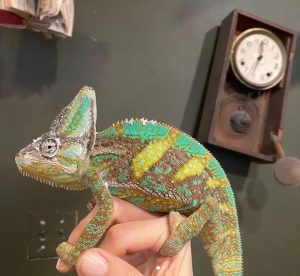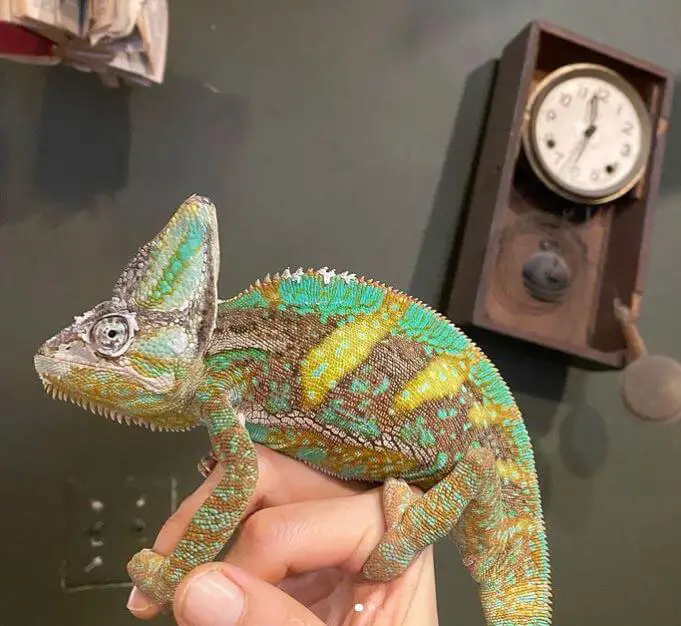How long are chameleons tongues
How long are chameleons tongues: Chameleons, with their mesmerizing ability to change colors and their distinctive appearance, have long captivated the imagination of nature enthusiasts and researchers alike. These remarkable reptiles belong to the family Chamaeleonidae, which comprises over 200 species spread across various regions around the world.
Renowned for their exceptional camouflage and unique hunting techniques, chameleons possess an array of intriguing adaptations that set them apart in the animal kingdom. Among these adaptations, one stands out as particularly fascinating: their long and lightning-fast tongues.
Chameleons possess a tongue unlike any other creature on Earth. While most animals rely on jaws or claws to capture prey, chameleons have evolved an astonishingly elongated tongue capable of rapidly extending to snatch unsuspecting victims with precision and speed.
Brief Overview of Chameleons as Fascinating Reptiles
Chameleons are arboreal creatures that primarily inhabit tropical forests and savannas. They are characterized by their zygodactylous feet—meaning they have toes grouped into opposing pairs—ideal for gripping branches during climbing maneuvers.
Their bodies are often adorned with intricate patterns and colors that aid in camouflage. One of the most captivating aspects of chameleon physiology is their independently moving eyes, which can rotate independently of each other.
This unique feature grants them panoramic vision and allows them to track prey or predators without needing to move their heads. Additionally, their skin contains specialized pigment cells called chromatophores that enable them to change color according to mood, temperature regulation, or environmental stimuli.
Teaser on the Unique Feature of Their Long Tongues
 While chameleons’ ability to change color is often what captures people’s attention initially, it is their extraordinary tongues that truly amaze. These elongated tongues have evolved to be an essential tool for chameleon survival, enabling them to swiftly capture prey from a distance without alerting their targets.
While chameleons’ ability to change color is often what captures people’s attention initially, it is their extraordinary tongues that truly amaze. These elongated tongues have evolved to be an essential tool for chameleon survival, enabling them to swiftly capture prey from a distance without alerting their targets.
Imagine witnessing a chameleon perched on a branch, seemingly motionless. Suddenly, its eyes lock onto an unsuspecting insect nearby.
In the blink of an eye—almost literally—the chameleon’s tongue darts out with remarkable speed and accuracy, ensnaring the prey before it has time to react. The entire process happens so quickly that it is almost imperceptible to the human eye.
In this article, we will delve into the intriguing world of chameleons and explore in detail how their long tongues function and contribute to their impressive hunting abilities. From their unique anatomy to the mechanics behind tongue extension, we will uncover the secrets behind this remarkable adaptation.
Understanding Chameleon Anatomy
Description of Chameleon’s Body Structure and Adaptations
Chameleons are remarkable reptiles characterized by their unique body structure and impressive adaptations. They possess a distinctive appearance, with a flattened body, bulging eyes that can move independently, and prehensile tails for gripping branches.
Their skin is covered in specialized cells called chromatophores, which allow them to change color for communication, camouflage, or thermoregulation purposes. The ability to alter their skin coloration is not only captivating but also plays a crucial role in their hunting techniques.
Emphasis on the Importance of Their Tongues for Hunting
While the entire chameleon anatomy is fascinating, one organ that stands out as crucial for their hunting success is undoubtedly their tongue. Chameleon tongues are highly specialized and adapted for capturing prey with astonishing precision and speed. The importance of the tongue cannot be overstated as it enables these reptiles to overcome challenges associated with hunting in arboreal environments.
The tongue functions as an extendable tool that allows chameleons to snatch insects from a considerable distance without compromising their position or alerting potential prey. This adaptation provides them with a distinct advantage over other predators by allowing them to reach insects located on leaves or branches that might otherwise be out of reach.
By utilizing their long tongues effectively, chameleons can remain hidden while ambushing unsuspecting prey from a safe distance. Moreover, the tongue’s speed plays a vital role in successful hunts.
When targeting small insects such as crickets or flies, chameleons need rapid tongue projection to catch agile prey before it has time to escape. With lightning-fast reflexes, they can extend their tongues up to one-and-a-half times their body length within milliseconds – making it nearly impossible for most prey items to evade capture.
Understanding the anatomy of chameleons, particularly the adaptations and significance of their tongues, provides a deeper appreciation for these remarkable creatures. Their unique body structure and specialized hunting techniques make them expert ambush predators in the intricate world of arboreal ecosystems.
The Mechanics of Chameleon Tongues
Exploration of the Lightning-Fast Tongue Extension
When it comes to capturing elusive prey, chameleons have evolved an exquisite mechanism to extend their tongues with unparalleled speed and precision. Within a fraction of a second, their tongues can shoot out from the mouth and snatch unsuspecting insects from a distance. This mesmerizing display is made possible by a complex combination of anatomical adaptations and lightning-fast muscle contractions.
At the forefront of this remarkable feat is the chameleon’s unique tongue projection apparatus. As chameleons prepare to launch their tongues, they actively contract specific muscles located in the throat region, generating an enormous amount of force.
The stored energy is then rapidly released when the chameleon relaxes these muscles, launching its tongue forward with impressive velocity. This intricate process occurs within milliseconds and allows for effective prey capture in a fraction of a blink.
The Marvelous Role of Specialized Muscles and Tendons
 To achieve such astonishing tongue extension, chameleons employ an intricate network of specialized muscles and tendons that work synergistically to facilitate rapid movement. These muscle groups include both longitudinal and radial fibers that span the length and circumference of the tongue structure respectively. The longitudinal muscles play a crucial role in extending and retracting the tongue swiftly while maintaining accuracy.
To achieve such astonishing tongue extension, chameleons employ an intricate network of specialized muscles and tendons that work synergistically to facilitate rapid movement. These muscle groups include both longitudinal and radial fibers that span the length and circumference of the tongue structure respectively. The longitudinal muscles play a crucial role in extending and retracting the tongue swiftly while maintaining accuracy.
These powerful muscles contract forcefully when activated by nerve signals, propelling the tongue forward at exceptional speeds. Conversely, when retraction is required, these muscles relax rapidly to pull back the tongue with pinpoint accuracy.
Additionally, chameleon tongues possess specialized tendons that act as elastic structures aiding in rapid extension by storing potential energy during contraction phases. These tendons work hand in hand with powerful muscles by acting as stretchable slingshots or springs, assisting in launching their tongues towards unsuspecting prey.
The combined effort of these extraordinary muscles and tendons enables chameleons to execute their lightning-fast tongue extension with astonishing precision and accuracy. Carefully crafted by millions of years of evolution, the mechanics behind chameleon tongues are a testament to nature’s brilliance.
This intricate system, involving specialized muscles and tendons that facilitate rapid tongue projection, allows these fascinating reptiles to snatch their prey from a distance in the blink of an eye. Now that we have examined the incredible mechanics of chameleon tongues, let us delve deeper into uncovering the mystery surrounding their astounding lengths.
Unraveling the Lengthy Mystery: How Long Are Chameleon Tongues?
Overview of general tongue length in various chameleon species
Chameleons, being a diverse group of reptiles, exhibit a wide range of tongue lengths. In general, the tongues of these remarkable creatures can extend anywhere from one to two times their body length.
Several factors contribute to this variation, including the species itself, age, and gender. For instance, among the larger chameleon species like the veiled chameleon (Chamaeleo calyptratus) or the Panther chameleon (Furcifer pardalis), tongues can reach impressive lengths.
Adult individuals of these species may possess tongues extending up to 1.5 times their body length or more. On the other hand, smaller chameleons such as brookesia minima are known for having relatively shorter tongues compared to their body size.
Mentioning common lengths ranging from 1 to 2 times their body length
When considering an average range for chameleon tongue length across different species and sizes, it is often observed that most fall within a proportionate span relative to their own body size. This means that a typical adult chameleon may exhibit a tongue that extends approximately one to two times its total body length. For example, let’s consider an average-sized adult male panther chameleon with a total length measuring around 12-14 inches (30-35 cm).
In this case, it is not uncommon for its tongue to extend as much as 24-28 inches (60-70 cm) when fully projected during hunting or feeding activities. However, it is essential to note that specific measurements can differ even within individuals belonging to the same species due to factors such as genetic variability and environmental influences on growth rate.
Highlighting variations based on species, age, and gender
Chameleon tongue length is not solely determined by species or size variations but can also be influenced by other factors such as age and gender. In some cases, males tend to possess slightly longer tongues compared to their female counterparts.
This sexual dimorphism may serve a purpose in enhancing their hunting efficiency or reproductive success. Furthermore, as chameleons grow older, their tongues also undergo changes.
Young chameleons have relatively shorter tongues compared to adults of the same species. As these individuals mature and reach their full size, the tongue also proportionally elongates.
It is important to recognize that while generalizations can be made about chameleon tongue lengths across various species, individual variation within each population should not be overlooked. The uniqueness of each chameleon’s anatomy and physiology contributes to the intricate tapestry of diversity within this fascinating reptilian group.
The Incredible Stretch: How Chameleons Achieve Long Tongue Lengths
Delving into the unique bone structure enabling tongue extension
Chameleons possess a truly remarkable ability when it comes to extending their tongues. This incredible feat is made possible by their highly specialized bone structure, which acts as a catapult for their projectile tongues. At the heart of this mechanism lies the hyoid bone, a flexible and elastic bone that plays a crucial role in tongue projection.
The hyoid bone in chameleons is an extraordinary piece of anatomy. It consists of several elongated and interconnected segments that allow for unparalleled flexibility and stretchiness.
These segments are connected by joints that enable them to move independently, creating a spring-like action when the tongue is launched forward. The unique composition of the hyoid bone gives chameleons the ability to extend their tongues at astonishing speeds with deadly accuracy.
Explanation of hyoid bone flexibility and its role in tongue projection
The flexibility of the hyoid bone in chameleons is instrumental in achieving their impressive tongue projection abilities. When at rest, this intricate skeletal structure folds neatly within the mouth cavity, coiled like a tightly wound spring ready to be released at any moment.
When hunting or striking prey from a hidden position, such as perched on branches or leaves, chameleons will suddenly contract specific muscles surrounding the hyoid bone. This rapid contraction causes immense tension on the bones and ligaments supporting it, ultimately resulting in an explosive release of energy that instantly propels their tongues forward towards unsuspecting prey.
Mentioning how hyoid bone connects to other skull bones for stability
 To ensure stability during tongue projection, the flexible hyoid bone connects intricately with other skull bones within a chameleon’s head. These connections provide essential support and allow for precise control over the trajectory and extension of the tongue.
To ensure stability during tongue projection, the flexible hyoid bone connects intricately with other skull bones within a chameleon’s head. These connections provide essential support and allow for precise control over the trajectory and extension of the tongue.
The hyoid bone attaches to several key points in the chameleon’s skull, including the palatine bones, pterygoid bones, and other cranial structures. This complex network of connections ensures that when the tension is released and the tongue is launched forward, it moves in a controlled and accurate manner.
The stable foundation provided by these skeletal connections allows chameleons to strike their prey with remarkable precision, even from considerable distances. Chameleons’ ability to achieve lengthy tongue lengths is a result of their unique bone structure.
The flexible hyoid bone acts as a catapult, providing an exceptional spring-like mechanism for propelling their tongues forward at high speeds. This flexibility is crucial for accurate prey capture and is supported by intricate connections to other skull bones that ensure stability during tongue projection.
The remarkable adaptations found within chameleons exemplify the marvels of evolution and showcase nature’s incredible diversity in anatomy and hunting strategies. (Note: Remember to integrate this section smoothly with your previous sections and continue with subsequent sections as per your article outline.)
The Powerhouse Within: Muscles Behind Chameleon Tongue Extension
Chameleons are truly remarkable creatures, not only for their color-changing abilities but also for their extraordinary hunting techniques. At the core of their hunting prowess lies a complex network of specialized muscles that enable rapid tongue projection with astonishing precision. These muscular structures, finely tuned by evolution, work together seamlessly to provide chameleons with unrivaled striking speed and accuracy.
Exploring the Specialized Muscle Groups Responsible for Rapid Tongue Projection
A critical component of chameleon tongue extension is the muscle system surrounding the hyoid bone. The hyoid is a small, U-shaped bone located in the neck region of chameleons and acts as an anchor point for various muscles involved in tongue projection. Two main muscle groups play a pivotal role in catapulting the tongue forward: protractors and retractors.
The protractor muscles are responsible for extending the tongue rapidly beyond the mouth cavity. These specialized muscles possess an impressive combination of strength and speed due to their composition of predominantly fast-twitch muscle fibers.
Fast-twitch fibers contract quickly and generate high levels of force, enabling swift extension of the tongue toward unsuspecting prey. The timing and coordination between these protractor muscles determine how far and accurately chameleons can strike their targets.
Highlighting Fast-Twitch Muscles That Generate High Acceleration Speeds
Another set of muscles working in harmony with the protractors are the retractors. These muscles retract or pull back the extended tongue after striking prey, ensuring quick retrieval for subsequent strikes or consumption.
While not as prominent as protractor muscles, retractors must possess adequate strength to counterbalance protraction forces while maintaining precise control over retraction movements. Similar to protractors, retractor muscles consist primarily of fast-twitch muscle fibers capable of generating rapid and forceful contractions.
These fibers allow chameleons to swiftly withdraw their tongues with remarkable speed, further enhancing their ability to capture elusive prey. The synchronized interplay between the protractor and retractor muscles allows chameleons to strike at extraordinary speeds, making them formidable predators in their natural habitats.
Chameleon tongue extension is made possible by a sophisticated network of specialized muscles working together to facilitate swift and accurate strikes. The protractor muscles, composed predominantly of fast-twitch fibers, provide the power necessary for rapid tongue projection beyond the mouth cavity.
Meanwhile, the retractors assist in retrieving the extended tongue quickly and smoothly. This intricate muscular system empowers chameleons with unparalleled hunting abilities, enabling them to capture prey with exceptional agility and precision.
The Sticky Secret: Adhesive Properties of Chameleon Tongues
The Marvelous Saliva Composition for Prey Capture
The ability of chameleon tongues to capture prey with astonishing accuracy and speed lies in their unique saliva composition. Chameleon saliva consists of a complex blend of mucus, proteins, and enzymes, all working harmoniously to aid in prey capture. The mucus component helps create a sticky adhesive surface on the tongue, enabling it to cling onto unsuspecting insects.
This remarkable adaptation allows chameleons to snatch their prey with unparalleled precision. One crucial element found in chameleon saliva is a group of specialized proteins known as mucins.
These mucins are responsible for providing the sticky texture that allows the tongue to grasp onto insects effectively. The mucins help create a thin film of adhesive substance that enhances the contact between the tongue and its target, ensuring optimal prey capture.

Saliva Viscosity: Ensuring Prey Retention
Viscosity, or thickness, also plays a significant role in aiding chameleons in retaining their captured prey upon contact. Chameleon saliva possesses an ideal viscosity that allows it to adhere firmly to both smooth surfaces and textured insect exoskeletons without immediately dripping off. This characteristic is critical because it grants chameleons ample time for swallowing their catch before it can potentially dislodge from their tongues.
The viscosity levels of chameleon saliva are carefully balanced to provide just enough stickiness without impeding the retraction process once prey is secured on the tongue. Too high a viscosity could hinder quick tongue retraction, while too low a viscosity may result in inadequate adhesion requiring multiple attempts at capturing prey effectively.
Evolutionary Perfection: Fine-Tuned Adhesive Properties
The remarkable adhesive properties of chameleon tongues have evolved over millions of years through natural selection. This finely tuned system provides chameleons with a distinct advantage in their hunting strategies. By relying on their specialized saliva, chameleons can capture prey from varying distances and angles, giving them unparalleled versatility in their foraging.
Additionally, the adhesive properties of chameleon saliva contribute to the stealthy nature of these reptiles. The stickiness allows for silent and swift hunting, as prey has little opportunity to detect an imminent attack before being captured.
The highly efficient prey capture mechanism showcased by chameleons is a testament to the wonders of natural selection, resulting in an exquisite balance between adaptability and efficiency. Chameleon tongues possess extraordinary adhesive properties due to the specialized composition of their saliva.
The combination of mucus, proteins such as mucins, and optimal viscosity ensures effective prey capture and retention. These unique adaptations have been honed over millennia through natural selection, granting chameleons unparalleled agility and precision when it comes to hunting their unsuspecting insect prey.
The sticky secret behind chameleon tongues highlights the marvels of evolutionary biology at its finest. (Note: No HTML tags are included in this response as per your request.)
Fascinating Feats: Examples of Impressive Prey Capture by Chameleons
Astonishing Precision: The Agile Tongue Strikes
When it comes to capturing prey, chameleons exhibit remarkable precision and agility. One striking example is the ambush hunting technique employed by certain species. These chameleons patiently wait for their unsuspecting victims to come within range, and in one swift movement, flick their tongues out with astonishing accuracy.
With lightning-fast speed, their tongues extend, propelling towards the prey with incredible accuracy. In a matter of milliseconds, the sticky tip latches onto the target, securing it firmly in place.
A True Ace: The Tongue’s Acrobatic Maneuvers
Chameleon tongues not only amaze with their length but also display acrobatic prowess during prey capture. Take for instance the Veiled Chameleon (Chamaeleo calyptratus), renowned for its ability to feed on elusive insects while perched high in trees. Their tongues can reach impressive lengths of up to twice their body size, allowing them to snatch fast-flying prey even from considerable distances.
As if this feat weren’t enough, chameleons can perform remarkable “spreading” actions with their tongues—using specialized muscles and ligaments—to widen its surface area upon contact with prey. This ensures an enhanced grip on struggling insects that might attempt escape.
A Feast for the Eyes: Spectacular Visual Adaptations
In addition to their extraordinary tongues, chameleons possess spectacular visual adaptations that contribute to successful prey capture. Their unique independently moving eyes allow them to have a panoramic view without moving their heads significantly.
This bifocal vision enables precise depth perception and facilitates accurate targeting of potential meals within complex environments such as dense foliage or intricate branches. With eyes capable of rotating almost 180 degrees, chameleons have a clear advantage in spotting even the most elusive prey.
To sum up how long are chameleons tongues
Through their incredible tongues and remarkable hunting abilities, chameleons showcase nature’s ingenuity and adaptability. These reptiles have evolved specialized anatomical features that enable them to capture prey with astounding accuracy. From their lightning-fast tongue strikes to their acrobatic maneuvers and visually impressive adaptations, chameleons are truly masters of their environment.
The study of these fascinating creatures not only deepens our understanding of the natural world but also reminds us of the innate beauty and complexity found within it. So, let us marvel at the extraordinary lengths to which chameleons go for a meal, appreciating the wonders that await in every corner of our planet.
Further Reading:
- Best Turtle Substrate For Your Pet Tank
- Coconut substrate for chameleons
- Caught my Chameleon eating moss


